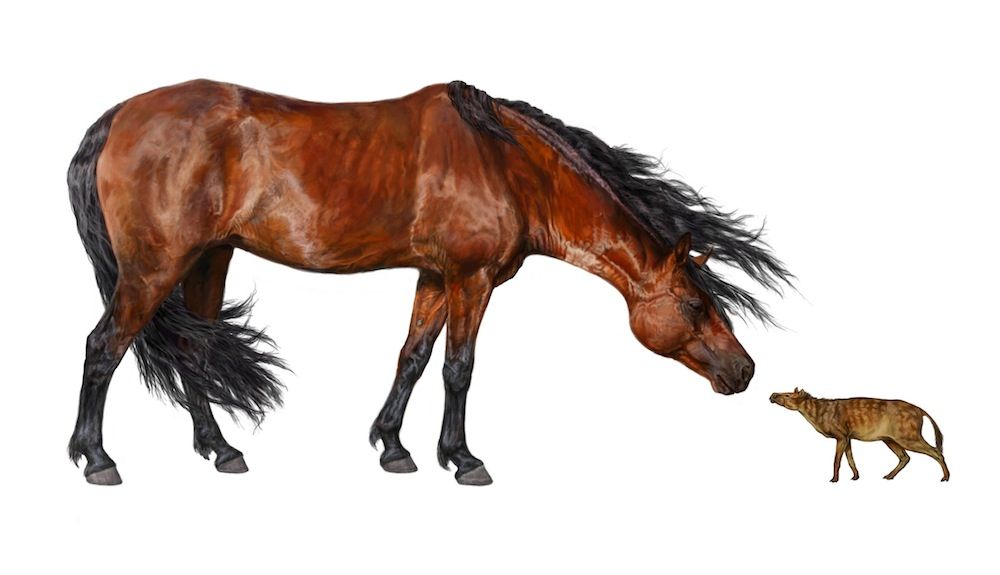
A warm snap more than 50 million years ago caused the tiny, adorable ancestors of modern-day horses to shrink, new research suggests.
With this new finding, there are two known instances of rising temperatures linked to decreasing body sizes, suggesting that rather than a fluke this phenomenon may be a general rule for mammals, the researchers said.
"There might be a relationship between the size of a hypothermal event and the extent of mammalian dwarfism," said Abigail D'Ambrosia, an earth sciences doctoral candidate at the University of New Hampshire, who presented her findings Nov. 1 at the 73rd annual Society of Vertebrate Paleontology meeting.
Warming event
Last year, researchers reported in the journal Science that during a slightly earlier, bigger global warming event, mammals decreased in size by about 30 percent. But it wasn't clear whether this tie between warming and shrinking mammals was a trend.
To find out, D'Ambrosia collected tooth fossils of several mammal species from the escarpments at Bighorn Basin in Wyoming. Paleontologists can extrapolate from tooth size to total body size. [In Photos: One-of-a-Kind Places on Earth]
The fossils dated to a period before and during the ancient warming event known as Eocene thermal maximum 2 (ETM2), which occurred about 53 million years ago. During ETM2, temperatures increased between 5 and 9 degrees Fahrenheit (3 and 5 degrees Celsius) for about 100,000 to 120,000 years.
Sign up for the Live Science daily newsletter now
Get the world’s most fascinating discoveries delivered straight to your inbox.
Tiny horses
In particular, the team found that the first horse species, called Sifrhippus, which is "about the size of a small dog," got smaller by about 19 percent over time during ETM2, D'Ambrosia said. In comparison, during an earlier, longer warm period in the Eocene Period, those same horses decreased in size by about 30 percent.
"They're seeing a very similar response to what we're seeing in the [earlier warming event]," said Ross Secord, a vertebrate paleontologist at the University of Nebraska-Lincoln, who was not involved in the study but has studied the earlier warming event. "That's important: Now we have a predictable pattern."
Scientists aren't sure exactly why mammals would get smaller with warmer temperatures. Perhaps they simply need to be smaller to allow for more efficient cooling, Secord told LiveScience. (Smaller animals have higher surface area relative to volume to exchange heat with the air, which means heat is gained and lost faster.)
Another possibility is that warming temperatures meant more carbon dioxide in the atmosphere.
"We know from experience that really high [carbon dioxide] levels in the atmosphere reduce the nutritional content of plants," Secord said. With less nutrition in their leafy food, mammals may have shrunk to compensate.
Not all living creatures react to hotter temperatures in this way. For instance, cold-blooded animals tend to get bigger during warmer periods.
If the findings can be replicated, it could help scientists predict changes in other mammals during modern global warming, D'Ambrosia said.
Follow Tia Ghose on Twitter and Google+. Follow LiveScience @livescience, Facebook & Google+. Original article on LiveScience.

Tia is the managing editor and was previously a senior writer for Live Science. Her work has appeared in Scientific American, Wired.com and other outlets. She holds a master's degree in bioengineering from the University of Washington, a graduate certificate in science writing from UC Santa Cruz and a bachelor's degree in mechanical engineering from the University of Texas at Austin. Tia was part of a team at the Milwaukee Journal Sentinel that published the Empty Cradles series on preterm births, which won multiple awards, including the 2012 Casey Medal for Meritorious Journalism.











